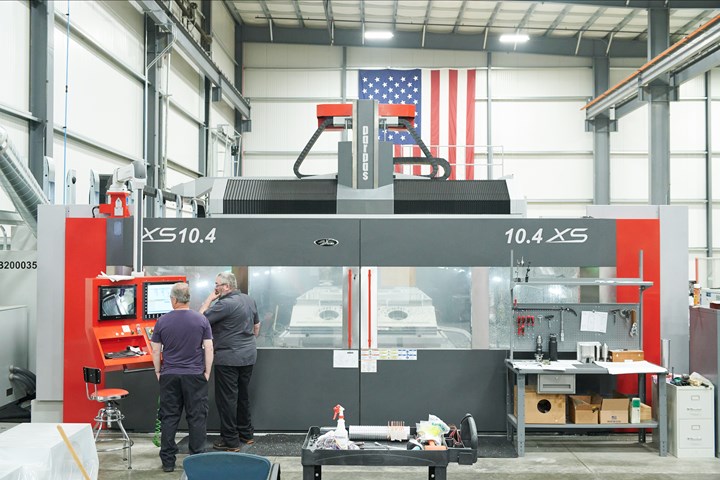Share




If you looked at Modern Machine Shop’s November 2021 cover and wondered what you were looking at, you are not alone. 
The cover of Modern Machine Shop’s November issue, photographed during the fall of 2021 at Major Tool. Photo Credit: Tim Schumm/Major Tool
Simply put, you are looking at the human component of machine tool automation: Employees of Major Tool & Machine in Indianapolis are standing inside a 10-meter Parpas five-axis machine using dial-bore and thread gauges to inspect a large aluminum part for the semiconductor industry.
The article about the company, which coincided with its 75th anniversary year, focuses on Major Tool’s systemized approach to confronting the skilled-labor gap, a strategy that involves developing and retaining talent and implementing various forms of automation.
This is not an uncommon strategy, of course. But what sets Major Tool apart from your typical machine shop is the sheer size of the parts the company produces — and the machine tools that are large enough to accommodate them. As the article states, when it comes to the dimensional and weight limitations of its parts, Major Tool & Machine is constrained only by the size of its bay doors and the legal weight limits for travel across America’s highways.
Pictured is Major Tool’s Parpas XS 10.4, the smaller of the company’s two large-format high speed machining centers. Both maintain a high degree of accuracy via air-cooled internal components. Photo Credit: Tim Schumm, Major Tool
The machine you are looking at is actually the smaller of Major Tool’s two Parpas large-format machining centers. You can read more about this and some of its other large-format machines in the original article, but here is what Mike Griffith, president of Major Tool, had to say when we asked him for a few comments about the cover photo for Modern Machine Shop’s November issue:
- The aluminum part being inspected is for silicon wafer production for the semiconductor industry.
- While the company uses in-process probing for many of its parts, critical bores and threads require manual inspection.
- The Parpas is a five-axis mill that also features a 90-degree, two-axis head attachment that nearly turns upside-down in order to machine difficult-to-reach areas of the part.
- The production time on this part is several hundred hours.
- If you look closely at the cover photo, you will see a round piece of aluminum in the bottom-left corner. Major Tool uses that piece for tool testing. “Before we're actually putting a tool on the part for the first time,” Griffith says, “we're going to test it to make sure it performs before we use it on the actual part.”
- Tim Schumm, the person who took the photo, is not only a professional photographer, but is also Major Tool’s IT manager.
Related Content
-
4 Steps to a Cobot Culture: How Thyssenkrupp Bilstein Has Answered Staffing Shortages With Economical Automation
Safe, economical automation using collaborative robots can transform a manufacturing facility and overcome staffing shortfalls, but it takes additional investment and a systemized approach to automation in order to realize this change.
-
Increasing Productivity with Digitalization and AI
Job shops are implementing automation and digitalization into workflows to eliminate set up time and increase repeatability in production.
-
Cutting Part Programming Times Through AI
CAM Assist cuts repetition from part programming — early users say it cuts tribal knowledge and could be a useful tool for training new programmers.






















.jpg;maxWidth=300;quality=90)




